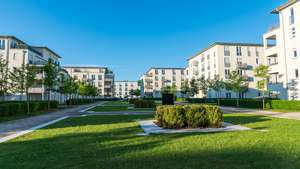
Improving the level of environmental safety in the process of the ecoenergoefficient reconstruction of the housing stock in Kiev.
 Tetiana Kryvomaz 1,
Tetiana Kryvomaz 1, Dmytro Varavin 2*
Dmytro Varavin 2*
1,2 Kyiv National University of Construction and Architecture, Vozduhoflotsky Avenue 31, Kyiv, 03680, Ukraine
Received: 10/20/2017, Accepted: 11/30/2017, Available online: 12/28/2017.
DOI: https://doi.org/10.32557/useful-1-2-2017-0003
HDL: http://hdl.handle.net/20.500.12334/35
*Corresponding author: e-mail: d.varavin@icloud.com
Under a creative commons license. Volume 1, Issue 2, 2017, pages: 19-29.
Author Keywords: reconstruction, building, housing stock, energy efficiency, environmental safety.
Abstract.
As a result of research into the state of the housing stock in Kiev and the prospects for its reconstruction, the main levels of implementation of eco-energy-efficient measures have been identified, taking into account the increasing cost / effectiveness ratio, which will include problem assessment, optimizing energy costs, eco-energy efficient housing reconstruction, application of innovative technologies. Based on the national and international experience of reconstruction and overhaul, the 6E concept is proposed, which focuses on energy efficiency, environmental safety, economy, ecology, ergonomics and aesthetics of the reconstruction process.
Compliance with the basic requirements of eco-energy efficiency in the process of housing reconstruction will ensure the comfort of residents and will improve the level of environmental safety of our country. Introduction of the principles of energy efficiency in the process of reconstruction of housing stock is an integral part of Ukraine's environmental and national security, as it ensures a reduction in the negative impact on the environment and people, and also significantly reduces the waste of the construction industry.
Introduction
Formulation of the problem. Reconstruction of hosing in accordance to the modern demands of energy efficiency and comfortability is one of the problems of ecological safety of Ukrainian cities. Urgent needs of modern life demand to overview the approaches to the housing policy forming by developing of programs on reconstruction and overhaul of housing which are oriented on energy efficiency. Recently in the countries with the developed economy there is a tendency of decreasing of investing in new housing. It has been caused, from the one hand, by housing loans decreasing for the most well-off people, from the other hand, by demand decreasing from the poorest category of population.
Moreover, there is a reorientation of investments from construction of new housing to reconstruction and modernization of the existing housing. And the question of reconstruction of outdated housing is especially acute in the capital and other big cities of our country, where the area for new buildings has been almost expired, particularly in the central parts. In order to increase the interest of owners of residential and non-residential premises Housing cooperative was created in residential buildings and the Energy efficiency technologies were implemented in housing fund; Kiev municipal council adopted the rule from 26.12.2014 No.865/865 "On confirmation of strategies on call for proposals of energy efficiency actions in residential houses of the city of Kiev in which the Housing cooperatives were created".
From 07.07.2016 No.565/565 the Kiev municipal authority adopted a decision on stimulating of implementation of energy efficiency measures in multi-family housing through compensation of a part of credits, and 26.12.2016 a decision No.780/1784 was adopted "On confirmation of the Rule on cosponsoring of reconstruction, remodeling, overhaul, technical re-equipment of the shared property in multi-family housing, in Kiev".
These programs give opportunities to increase energy efficiency and energy saving of the housing in the capital, to decrease costs of the residents on housing and communal services and to provide them with comfortable living conditions.
Analysis of publications and research. Recently the problem of energy efficiency is paid much attention to not only in social and political sphere but in scientific studies of many native researchers. In particular, in the studies by Y.V.Orlovska the contingency allowances of economic potential of Residential sector are determined, the ways of increasing of energy efficiency of residential construction and energy consumption are defined, the ways of increasing of energy efficiency of residential construction on the regional level are suggested as well as the energy saving policy.
The source of financing of the measures on houses energy efficiency increasing and the programs of financing for increasing energy efficiency of residential houses were analyzed according to the regions in the studies by O.V.Komelina and S.A.Shcherbinina [4]. In the studies by M.M. Klymchuk there was hold the content analysis of the existing ways for energy saving realization and the author also suggested their classification. THERE WERE also suggested the strategy priorities of state policy and the implementation of the modern concepts of energy saving, in particular "Green Lease", "Passive House" and "Triple Zero"[3]. Although in the mentioned above studies there was paid much attention to economic aspect of housing reconstruction and it was not paid at all to the very important aspect as the influence of the reconstruction process on ecological safety of environment and human.
According to the information from State housing infrastructure of Kiev municipal authority as of 01.07.2017 in Kiev there are 11,453 residential houses, among them 8407 - are of communal property, 900 - houses of building society, 534 - houses built at the expense of citizens. In 2016 in general in Kiev there were taken into operation 247 residential houses with total area 1334,0 thousand m. 2 at the expense of new residential houses and reconstruction of the existing fund; that was 97.7% from the amount excepted in 2015 [1]. In Kiev in the beginning of 2017 there were 55.4 thousand m2 of outdated housing that was 0.1% from the total amount of housing [2]. Number of inhabitants who had residence registration in these houses was 1616 people (tab. 1).
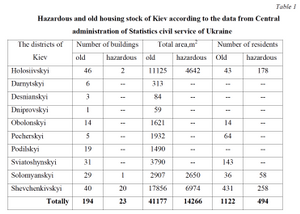
Percentage ratio of housing in Kiev equipped by measuring equipment according to the data from Department of Housing, Utilities and Amenities of Kiev municipal authorities is presented in the table 2. According to the published data of JSC "Kievvodokanal" today 98,73% of multi-family houses and 39,1% houses in private sector are equipped with individual water counters in Kiev.
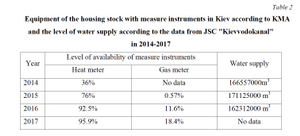
Verkhovna Rada of Ukraine on 22, June 2017 adopted the Law of Ukraine No. 4901 "On commercial accounting of thermal energy and water supply". The law provides compulsory equipment with measure instruments all buildings connected with external thermal networks as well as with hot and cold-water supply. According to the Law, such meters have to be equipped by the operators of external networks till 1, October 2018 in residential houses. Besides, according to the adopted Law the equipment with individual meters or devices-distributors of heat consumption will be compulsory for multi-family houses.
In State Agency for Energy Efficiency they consider that 100% of implementing of heat and water consumption accounting by the residents will allow to reduce energy consumption by 15-20%. That can be the reason of the tendency to reducing of water supply by the population of Kiev; this is observed during 2012-2014 (pic. 1).
But it was more likely because of the correlation with economic crisis and social instability as the dramatic decrease of water consumption was in 2014. From the other hand, the experience of developed countries shows that the equipment of housing stock with measuring instruments is the necessary and substantial step to energy efficiency.
So, if the necessity and expediency of energy principles while reconstructing the housing stock are beyond doubt, the methods of practical usage of the process cause many problems. Moreover, now there is not formulated general concept of energy efficiency reconstruction of housing stock of Ukraine despite the fundamental grounding in scientific literature in the developed countries, which is appropriate to adapt to Ukrainian conditions considering the best domestic experience.
Presentation of the main material of the study
Goal of research. To formulate the general concept of energy efficiency reconstruction of the housing stock considering the necessity of ecological safety improving of Ukraine.
Statement of basic materials. Taking into account costs and difficulty of reconstruction process of housing stock we have specified the four main levels of the energy efficiency approach:
- Realization of the problem, receiving and distribution of the necessary information;
- Energy Cost Optimization;
- Energy efficiency reconstruction of houses;
- Application of innovative technologies.
At pic. 2 these levels are given in ascending order of the ratio costs/efficiency.
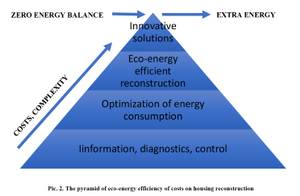
The first level of the pyramid includes the realizing of the problem and informing all concerned about the necessity of energy efficiency approach to the process of reconstruction of houses. According to the ratio costs/consequences this step is the most effective even with minimum funds. Diagnostics of heat losses and measuring instruments installation need more resources but this allows getting to the next level - the Energy Cost Optimization.
To reduce the energy consumption is possible without drastic reconstruction. One can reduce the costs by 20-30% only with smart planning of space heating and room illumination. It takes much expense to change electrical equipment, windows and heating systems, but the effect from these measures provides stability though it is the long compensated one. Heat insulation of a house provides to 50% of cost saving and the changing of windows to more energy efficiency saves to 15% of costs. Six classes of house energy efficiency have been defined by the regulatory documents DBN B.2.6-31:2006 and DSTU-N B A.2.2-5:2007. This gives opportunity to unify the appropriate economically grounded measure on energy saving in houses that are different in construction period, constructive and engineering decisions, design standards, application conditions as well as in investment attractiveness of the construction, reconstruction, overhaul (thermal modernization) and buildings operation.
Reconstruction of houses needs the well-structured approach and detailed planning considering expenses and calculation of energy efficiency and ecological safety on each level.
Investments for environmental protection and innovative technologies are also stimulated. Despite the dramatic development of innovations in the sphere of energy efficiency the usage of new technologies are limited considerably because of their high cost and difficult operation process. All these disadvantages are brought into a level position if scaled-up and mass used. That is why it is very important to distribute the achievements in innovative energy efficiency technologies primarily among the well-off population and also to provide substantial support on the state level.
Such approach facilitates the energy efficiency technologies quality increasing and their cost decreasing, that will help to use the progressive innovations by all people in future regardless of their wealth. Full energy efficiency reconstruction allows to reach the zero and even the profitable balance of houses energy consumption.
For improving of the houses reconstruction process, it was suggested the concept 6E that emphasizes the energy efficiency, ecological safety, economy, ergonomics and esthetics of reconstruction process of residential houses. (pic. 3)
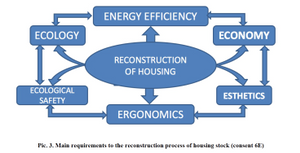
Energy efficiency. The widely accepted world leader in the sphere of energetics and ecological design is the international rating system of building certification LEED that estimates the efficiency of the most important indicators, in particular, of energy saving, water use, reducing of CO2emission and quality of premises condition in the context of their impact on human and environment. In the process of estimation, they consider the list of standards which are constantly improving. In particular, "Standard for the Design of High-Performance Green Buildings" states the regulations for location, design, construction and functioning of buildings while balancing ecological responsibility and impact on environment.
For energy efficiency regulation of heating, refrigerating and conditioning systems they use the standards of American Society of Heating, Refrigerating and Air-Conditioning Engineers (ASHRAE). Energy efficiency of construction materials and household goods is estimated in accordance to the international standard Energy Star - this is the indicator of energy efficiency of a building in which the mark 50 indicates average efficiency of a building. They also support such construction projects in which there is a place for renewable energy sources and for the infrastructure connected with them.
Such approach allows to distinguish the main steps and the key components, which you should pay attention to in the process of reconstruction of buildings basing on energy efficiency. In particular you need to calculate energy expenditure and their impact on environment and human during all life periods of a building. The indicators of successful implementation of ecological principles by construction companies is the efficiency of usage of materials and energy, number of kilometers driven, number of waste products and the percentage of their recycling.
Ecological safety. The tight and symbiotic relationship between energy efficiency and ecological safety is caused by the number of objective factors. Firstly, the energy efficiency approach in the process of reconstruction provides the reducing of negative impact that is traditionally high in the sphere of construction. Secondly, the increasing of comfort and micro climate of indoor premises as well as elimination of hazard factors will improve the life quality of the residents. Thirdly, the implementation of the methods of eco-economic estimation of life cycle of materials and constructions will allow to substantially reduce amount of wasted materials and negative impact at the levels of material producing, construction and maintenance of dwellings.
Emission of CO2 must be paid special attention to as well as to other polluting substances (NOx, SO2, CO, saturated carbon, Pb, Cs, Hg and others). The frequency of accidents and hazardous situations that are harmful to environment are also taken into account. Minimization of operational and ecological risks in the process of construction, appliance of energy efficiency buildings will allow to reduce the dependence on imported energy products and as a result will provide the increasing of national safety.
Ecology. The main tools of energy efficiency reconstruction of houses are rational use of energy, water and other resources, the achieving of physical and functional comfort by control of temperature, humidity, light, acoustic loads and ventilation. The specified demands are put forward the organization of building area; the premises and additional infrastructure are planned carefully. The realization of energy efficiency projects is aimed to increase the buildings quality, their indoors premises and surroundings.
The most suitable condition of indoor premises and control of temperature and humidity prevent from expansion of hazardous organisms that can destroy constructions and have negative impact on public health. Using some species of plant as interior decoration allows to purify air naturally and to lower costs on premises conditioning. As for external planting around the houses it is recommended to use local plants and avoid the invasive species. Close bushes can become an alternative to the standard fences as they do not only protect the territory but are able to absorb noise, to protect from sun and to purify air.
Arbuscular bushes with distributed root systems can avoid abrading thereby saving costs on strengthening of slopes with standard methods. There should be foreseen in advance special areas for parking of electric cars, bicycles, devices of rain water energy use near the houses that will substantially increase the eco-level of the reconstruction project.
Economy. You should note economic effect as a result of appliance of energy efficiency principles while reconstructing a house. It is not only a direct economy of residents but the great improvement of economic status of a country. Combination of ecological and economical process of reconstruction is reached by reducing of the level of consumption of energy and material resources during the whole life cycle of the building, its impact on surrounding territory and health of the residents.
Estimation of a life cycle inventory is implemented in accordance to the standards ISO 14044 [7],[8] where they take into account materials, harness of energy, air pollution, use of water and land resources at each step of reconstruction. This includes obtaining and gathering of materials and fuel source in nature; processing of building materials and producing of components for construction; transporting the materials and components; assembling and construction; technical maintenance, repair and change during operational phase with energy consumption; demolishing, recycling and repeated usage of a building in the end of its life cycle. Independent non-profit organization Green Seal defines eco-economical benefit of products and goods and recommends to use the most appropriate ones. There are a lot of organizations, programs and standards which help final customer to estimate energy efficiency and ecological level of building materials, goods and processes.
For certification of companies which process, produce and sell materials from wood there is the Chain of Custody method, according to which you can investigate the chain of delivery and the component of "saved material" is also taken into account (waste recycling) in accordance to the norms, criteria and standards of ISO/IEC Guide 59 or WTO Technical Barriers to Trade. The standards of ISO 14021 series estimate ecological aspects of goods, services and waste recycling materials [6].
Only precise calculation will help to define the appropriate balance and to reach high levels of energy saving and ecological safety during the process of reconstruction of residential houses. Indicator of financing of residential sphere is one of the main indicators of business "health" of the country. The appliance of energy efficiency principles during reconstruction of houses provides not only cost saving for residents but also the improvement of state's economic status in general.
Ergonomics. During the process of energy efficiency reconstruction much attention is paid to comfortable planning of premises and additional infrastructure considering specifics of the house's residents. As the main conditions of rational ergonomic reconstruction, we may consider comfortability and interaction of specific components of the system "human and his home environment ".
Modern life leaves little free time so people prefer comfortable and at the same time the most effective everyday conditions and their technical maintenance. The level of satisfaction and comfort of living depends on simplicity of use of home and time which is spent on everyday concerns. In addition, ergonomic planning of heat systems, light and utility systems allows to reduce operating expenditures.
Esthetics. Attractive esthetics of energy efficiency construction is able to improve social and emotional state of the Ukrainians, it can attract attention to the problems of environmental pollution and demonstrate the ways of their solving as well as promote the improvement of image of Ukraine.
Adaptation of international standards for implementation of energy efficiency principles in the process of reconstruction of housing stock of Ukraine and appliance of methods of eco-economic estimation of a life cycle of materials and constructions will allow to significantly reduce the amount of waste products at the levels of producing of materials, constructing of buildings and maintenance of dwellings.
Energy efficient approach in the process of reconstruction provides the reducing of negative impact on environment that is traditionally typical for construction sphere. Increasing of comfort and micro-climatic conditions as well as elimination of hazardous factors influence positively on health and life quality of the residents.
So, implementation of energy efficiency principles during reconstruction of housing stock of Ukraine is integral part of ecological and national safety of our country. Using the energy efficiency houses will allow to reduce the dependence from imported energy products and will promote increasing of national safety in general.
Conclusion
As a result of the research on prospects of reconstruction of housing stock in Kiev we have made the following conclusions:
- There were separated four main levels of the process of reconstruction of housing stock considering the increasing of the ratio costs/effectiveness: a) Realization of the problem, receiving and distribution of the necessary information; b) Energy Cost Optimization; c) energy efficiency reconstruction of houses; d) application of innovative technologies.
- It was stated that the implementation of the principles of energy efficiency reconstruction of housing stock is an integral part of ecological safety as it provides the decreasing of negative impact on environment and human as well as allows to significantly reduce the amount of wasted materials in construction sphere.
- The conception 6E was suggested which emphasizes energy efficiency, ecological safety, economy, ecology, ergonomics and esthetics of the process of reconstruction of housing stock.
- Following the main requirements of energy efficiency in the process of reconstruction of houses will provide comfort for residents and will allow to increase the level of ecological and national safety in Ukraine.
References
[1] N.F. Kostetskyi, A.I. Gurko. “Foreign experience of housing stock restoration and its preservation and modernization”. - Construction Economic.-2003-№5.-p.33-45.
[2] A.P. Dmitriev, R.B.Orlovich, E. Shafranka. “Foreign experience of modernization of large-panel buildings”. highschool Cnstruction - 2002. №1-2.-p.8-12.
[3] “Management of municipal economic development”. - edit. G.U.Vetrov -M.: Institute of city economics, 2009. -258p.
[4] V.V. Korzhenko, V.M. Lebediev. “Reconstruction technology of buildings”. M.: Association of construction universities, 2007. - p.224.
[5] “Practice of overhaul organization in multistory building in the countries of Eastern Europe and Baltic countries: experience useful for Russia”. -M.: Fund of "city economy", 2007. -12 p.
[6] Asaul A.N., Kazakov U.N., Ipanov V.I. “Reconstruction and restoration of real estate objects: text book” - edited by A.N.Asaul., 2005. 288 p.
[7] Comerio M.C. “Housing Repair and Reconstruction After Loma Prieta” [electronic resource]. URL: http://nisee2.berkeley.edu/?cat=89 (date : 08.06.2017).
[8] Onishchuk G.I. “Tendency of settlements development and housing problem”. - Materials of the second international scientific practical conference "Housing reconstruction". Kyiv,2000. P. 21-25.
[9] Frankivskyi A.A. “Modernization of engineering equipment - Priority direction of energy saving while housing reconstruction”. NRI "NRIproektrekonstruktsia". - Housing reconstruction. 2001. Ed. 2. P. 15-25.
Please cite as: T.Kryvomaz, D.Varavin, “Improving the level of environmental safety in the process of the ecoenergoefficient reconstruction of the housing stock in Kiev.” USEFUL online journal, vol. 1, no. 2, pp. 19–29, December 2017. DOI: https://doi.org/10.32557/useful-1-2-2017-0003



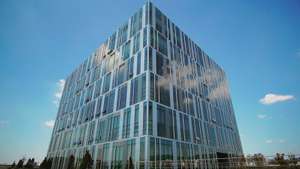

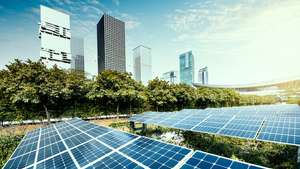


Comments